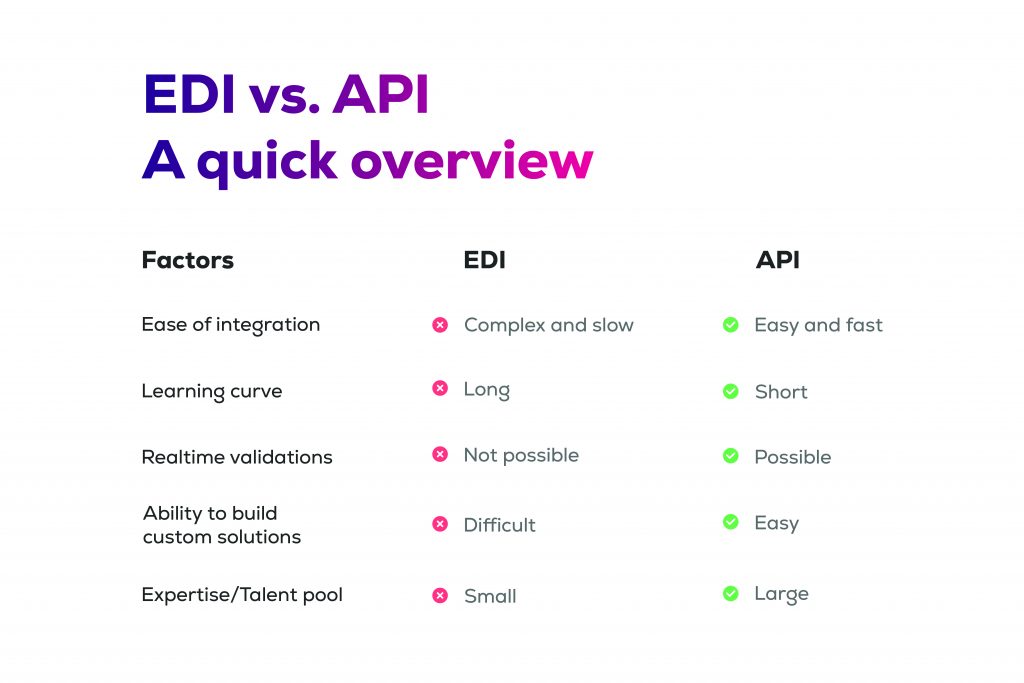
EDI vs API – Definitions, Differences & Benefits
On January 25, 2023 by Shivam RawatWhich is more promising in EDI vs API? You may have found yourself pondering over this question at some point if you have recently started searching for an API for EDI integration solution.
In just a few decades, the global data exchange in supply chains has evolved 100x to the point where delays and inaccuracy are simply intolerable for a company’s growth. And data exchange relies on B2B integrations (EDI and API). Before you decide on your integration software, it’s important to understand the basics.
What is EDI?
EDI (Electronic Data Interchange) is an electronic version of business documents such as Purchase orders, Invoices, etc. An EDI file contains important data points arranged in a standard format. The standard is created by industry organisations such as ANSI x12 and UN EDIFACT. For example, a purchase order EDI will have the purchase order number, quantity ordered, products ordered, and other related data points. Similarly, an Advance Shipment Notification (ASN) will contain data points determining the shipment information that is set to arrive.
Before the dawn of computers, this exchange took place on paper and emails, but for a large-scale environment such as retail, these methods cannot scale. That’s why EDI came into existence a few decades ago.
What is API?
APIs are a way for software systems to interact with external software systems. This happens through a protocol known as the HTTP protocol. A client system sends a request (in simple words, a question to access information) and the server system sends back a response (the answer). This has created a way for two systems to exchange information in the modern era. This is how the entire modern application works.
For example, this is how Facebook can access your current location. It can access the API provided by your Mobile OS to access your location (If you have given the Facebook app permission to do so). Similarly, you can fetch the list of orders that you received at Walmart. Walmart has an API for EDI that organisations can use to trade with them.
Many industry giants are moving a majority of operations to APIs as it is capable of integrating the latest systems into work environments.
Technical differences between EDI and API
Let’s take a look a closer look at the technical differences between EDI and API:
| EDI | API | |
| Data container | File | HTTP request and HTTP response |
| Communication method | AS2, SFTP | HTTP, HTTPS |
| Data structure | ANSI X12, EDIFACT, VDA, or any other EDI standard commonly used | Designed by the API host. |
Benefits of using EDI vs. Benefits of using API
While both EDI and API get the job done for B2B integrations, there are critical differences that may be beneficial or detrimental to you depending on the type of existing B2B integration infrastructure you have and the kind of developer resources you have inside your organisation.
| EDI | API |
| Hard | Easy |
While you might get used to the structure of EDI standards if you are an EDI expert, for the average modern-day developer, hands down, API data structures such as JSON or XML are far easier to understand and deal with. Many businesses are now adopting an API for EDI approach to simplify these integrations.
EDI data:

JSON data:

Ease of integration
| EDI | API |
| Hard | Easy |
The toolset that exists to code, test, deploy and maintain B2B integrations in production is just abundant. API for EDI toolsets are far more cutting-edge, mature, and easy to use as opposed to traditional EDI software or platforms.
Quality of data
| EDI | API |
| Prone to bad data | High-quality data with real-time validation |
Imagine you have applied for a visa and booked your tickets simultaneously, and you don’t hear from the authority for days until the day of your journey when they say your visa is ‘declined’. Your tickets and entire itinerary has gone waste. I couldn’t imagine how you’d feel. But this is exactly what’s wrong with EDI even today – the lack of real-time validations.
API improves data accuracy and eliminates invalid data in real time. If you submit an invalid request, API can validate your data against your trading partner’s requirements and can reject it. This eliminates bad data. This also eliminates chargebacks if your trading partners levy chargeback fees on you for sending bad data.
Ease of automation
| EDI | API |
| Hard | Easy |
Whether it’s your ERP, WMS or financial software, most modern-day systems interact with each other using API. That’s the world we live in today. Integrating your systems using an API for EDI ensures streamlined workflows. While it is not impossible to connect your EDI pipeline with other systems, it’s hard and difficult, and data transformations must be performed before you can get EDI data out as XML or JSON. This makes end-to-end automation hard.
On the other hand, with API, you can readily integrate your data with external systems and automate your entire workflow end to end.
Availability of talent pool
| EDI developers | API developers |
| Small and rare | Commonly available |
According to StackOverflow, the most commonly available talent pool is API programmers. You cannot expect modern developers to learn traditional EDI means unless you’ve got good reasons to keep them interested for a lifetime. It is time that we benefit ourselves with the resources that are available in the market rather than looking inside a drying pool. EDI developers are becoming scarce, and asking them to customize EDI processes outside their regular integration errands is another headache that you don’t want.
EDI vs API – Conclusion

EDI is only around because many major organizations have heavily invested in them in the past. They can’t just let EDI dissolve without returning their investments, which is understandable. That’s why they should consider complementing their EDI infrastructure with APIs. It can be done by building the API layer on top of your existing EDI infrastructure. The data from API could be converted into EDI and sent to existing EDI infrastructure. There’s a new wave of API-based EDI software designed for the modern-day developer. You can read about them here.
Increasingly big organizations such as Amazon & Walmart are going the hybrid way. While they have had EDI channels for years, they are opening up parallel API channels for integrations as well. This trend is set to continue for the reasons listed above in the benefits section. While it is tempting to be diplomatic, the fact is, in a modern world, for an average modern-day developer, APIs are far easier when it comes to performing B2B integrations.

Leave a Reply